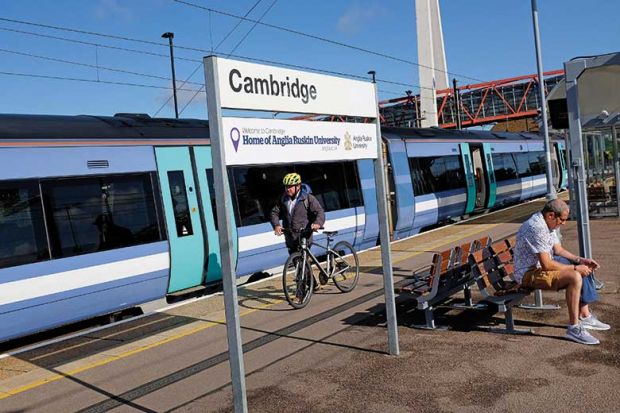Roll into Cambridge railway station – which gets bigger and more crowded on every visit – and although well outside the historic centre, the dominance of the university is immediately obvious.
The first thing you see is Cambridge University Press, with its enormous sign, which comes into view as the train slows on the approach.
Step out of the station and you are into an expanse of smart apartment buildings that have sprung up on the back of the university city’s appeal to the likes of Amazon, Microsoft and Apple.
Among them is a former flour mill now repurposed for luxury duplexes, while an adjacent block provides upmarket accommodation for students.
So far, so predictable, you might say, when universities and tech are the boom industries of our time.
But there’s one surprise at Cambridge station that makes me smile every time I see it.
The signs when you alight say “Welcome to Cambridge” and then in smaller print: “Home of Anglia Ruskin University”. Top marks to whoever in the marketing department came up with that one.
The success of the city is, of course, well chronicled – the mix of elite students, graduates, tech and research feed the phenomenon known as the Silicon Fen. For those involved, the benefits are obvious: high-paying jobs, soaring property prices, rising tax revenues and innovation that sets Cambridge apart from the Brexit-voting hinterlands outside the south east.
But even within Cambridge, there are haves and have-nots. Try buying a house in the city as a local primary school teacher, for example.
Another question that is not often raised is how Anglia Ruskin – which has a long-standing presence as the city’s “other” university – has fared in the University of Cambridge’s shadow.
Is there some symbiosis that works in the favour of the less-heralded institutions that share space with leading lights? Or has it been held back?
This is the question posed in our cover story this week, using the other Cambridge (in Massachusetts) as our case study. About 50 higher education institutions cohabit in the greater Boston area, of which seven are inside the top 250 of the Times Higher Education World University Rankings.
By extension, that leaves 40 or so that are not among the global elite, and – as our feature explores – proximity to Harvard, MIT and the other marginally less renowned institutions nearby can undoubtedly be an amplifier and accelerator of their own strengths.
Whether it is students, many of whom are attracted to celebrated university cities (which also appeal to anxious parents), or academics, who often need to source not one but two jobs because of the common “two body” problem of academic spouses, there are various practical benefits.
Our report also cites the windfalls that less prestigious universities can enjoy when high-flying academics at a city’s elite university decide they want a change of scene or environment but do not want to leave the local area.
Similarly, there are bargains to be had in terms of early career researchers coming out of PhD programmes, not to mention the potential for collaboration in research and use of shared facilities.
However, it would be a mistake, our analysis suggests, to overcook such benefits – the reality is that while collaboration is often encouraged, it cannot be forced, and when there are significant mismatches between institutions, examples of strong research links are rare.
The lesson for lesser lights, perhaps, is that trying to emulate or compete with a globally focused superstar institution is to chase rainbows – far better to focus on individual strengths and take whatever marginal benefits may exist as a bonus.
As one scholar at Nanyang Technological University puts it, asking him whether he would rather work at the higher-ranked National University of Singapore “is like saying to someone in a start-up: ‘Wouldn’t you rather work for IBM?’…I suppose it’s possible, but that might suggest they were in the wrong place anyway.”
None of this will be news to those working in universities. But it does serve as a reminder that breadth of provision and diversity of approach and mission are crucial to healthy higher education systems. Not all can be “world class” – nor should they be.
POSTSCRIPT:
Print headline: Life in sun and shadow
Register to continue
Why register?
- Registration is free and only takes a moment
- Once registered, you can read 3 articles a month
- Sign up for our newsletter
Subscribe
Or subscribe for unlimited access to:
- Unlimited access to news, views, insights & reviews
- Digital editions
- Digital access to THE’s university and college rankings analysis
Already registered or a current subscriber?





